Analys
Bulls recover their confidence as US crude stocks draws lower
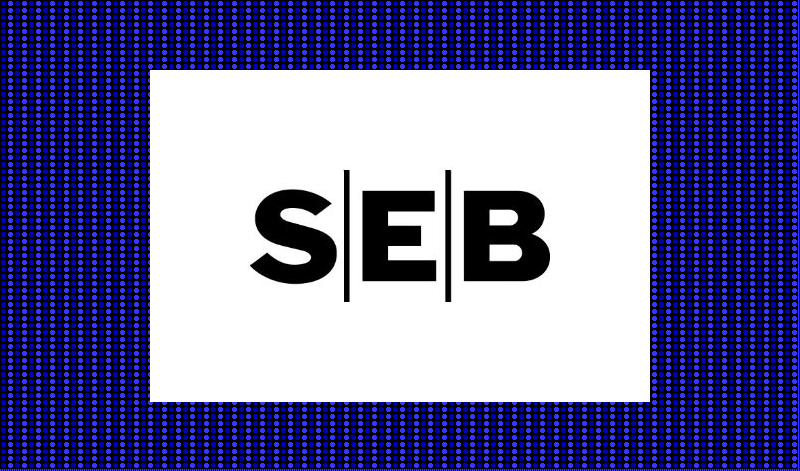
 Over the past week we have seen some sharp moves to the downside with Brent trading down to below $47/b before recovering. The sell-off was partly in a joint sell-off together with industrial metals. Possibly on the back of general commodity profit taking as some indications pointed to a peak in growth momentum.
Over the past week we have seen some sharp moves to the downside with Brent trading down to below $47/b before recovering. The sell-off was partly in a joint sell-off together with industrial metals. Possibly on the back of general commodity profit taking as some indications pointed to a peak in growth momentum.
There is clearly a widespread consensus that OPEC will roll cuts over into H2-17. The decision is however still ahead of us and as such is an uncertain element which creates some hesitation in the market. Better safe than sorry and as such we are likely to head into the meeting most likely at the low side of the prise spectre with a bounce up after the meeting with what now seems likely a positive decision by OPEC to roll cuts over into H2-17. Trading Brent crude at around $51-52/b ahead of the meeting with a jump up to $56/b post the meeting seems sensible.
We have seen some aired concerns that oil demand growth is coming in much weaker than expected with a growth rate as low as 0.8 mb/d y/y in H1-17. We find it hard to believe at the moment that there should be reason to be concerned for such a soft global oil demand growth in 2017. Overall oil demand growth is quite steady and fairly well related to overall global economic growth. In 2014 we had the exact same kind of concern where oil demand at times was estimated as low as 0.7 mb/d y/y. In hindsight though it has been adjusted up to 1.4% y/y for that year or +1.3 mb/d oil demand growth in 2014.
The US EIA on Tuesday released its monthly Short Term Energy Outlook (STEO) for May. It adjusted global supply up by 0.2% for both 2017 and 2018 while demand was lifted by 0.1% for each year. Net it saw a global surplus of 0.17 mb/d and 0.47 mb/d respectively for the two years. With a slightly higher projected surplus it adjusted its Brent and WTI price forecast down by 3% each for 2017 to $52.6/b and $50.7/b respectively for the two grades. The price forecast for 2018 was kept unchanged at $57.1/b and $55.1/b respectively for Brent and WTI. With a projected surplus for both 2017 and 2018 it naturally saw no draw down in OECD inventories neither in 2017 nor in 2018. It projected OECD ending stocks to end 2018 at 3109 mb which was 2.2% higher than in its April report and above the 2016 ending stock level of 2967 mb. Such an outlook should mean that the contango in the crude oil curves should be just as deep in 2017 as in 2018. It is a bit difficult to understand why they have a higher price forecast for 2018 than for 2017 when inventories are rising in 2018. The forecast for 2018 is actually 8.5% higher in 2018 than for 2017. The only explanation for such a view is that cost inflation will push prices higher.
US crude oil inventories yesterday showed a decline of 5.8 mb last week with gasoline declining 0.2 mb and distillates declining 1.6 mb. That gave the market back a lot of confidence. Total crude and product stocks in the US has actually been falling since mid-February but very high inventories for crude specifically has created lots of discomfort for the oil bulls this spring. Yesterday however some of those concerns were eased. The US EIA also estimated US crude production to be 9.3 mb/d last week (+21 kb/d w/w). In its STEO report on the EIA projected that US crude production would rise to 9.7 mb/d in November 2017 and thus pas its prior peak of 9.6 mb/d.
In perspective it is good to take a look at the current global rig count. It stood at 3656 rigs in 2014 while it stood at 2065 rigs in March according to OPEC. Also, it actually fell 42 rigs mth/mth from February. From 2014 to the latest count there is a drop of 43%. If we adjust for US shale oil volume productivity where today’s 600 shale oil rigs are as effective as 1200 rigs in 2014 we still get that the effective real decline in oil rigs is about 30% since 2014. Our ball-park figure is that only 20% of global upstream oil investments are needed to cover the global oil demand growth of some 1.3 mb/d y/y. The other 80% of upstream investments are basically used to produce oil that will counter declining production in existing production. The same goes for oil rigs. Only 20% of the rigs are needed to cover oil demand growth. The other 80% are needed to cover declines. Thus a 20% decline in real, global rig count will lead to no growth in global oil production. The above rig count does however not dissect between rigs used for prospecting versus rigs used to create production rigs. And as such the decline gives a misleading picture since prospecting for oil was the first to be cut in the downturn.
In the shorter term price picture we believe that Brent crude front month will head towards $51-52/b ahead of the OPEC meeting. Technically it then first out needs to break above $51.1/b and then more importantly above $51.67/b. Breaking above the later would technically be a goodbye to the downside technical correction we have had lately.
Kind regards
Bjarne Schieldrop
Chief analyst, Commodities
SEB Markets
Merchant Banking
Analys
More weakness and lower price levels ahead, but the world won’t drown in oil in 2026

Some rebound but not much. Brent crude rebounded 1.5% yesterday to $65.47/b. This morning it is inching 0.2% up to $65.6/b. The lowest close last week was on Thursday at $64.11/b.

The curve structure is almost as week as it was before the weekend. The rebound we now have gotten post the message from OPEC+ over the weekend is to a large degree a rebound along the curve rather than much strengthening at the front-end of the curve. That part of the curve structure is almost as weak as it was last Thursday.
We are still on a weakening path. The message from OPEC+ over the weekend was we are still on a weakening path with rising supply from the group. It is just not as rapidly weakening as was feared ahead of the weekend when a quota hike of 500 kb/d/mth for November was discussed.
The Brent curve is on its way to full contango with Brent dipping into the $50ies/b. Thus the ongoing weakening we have had in the crude curve since the start of the year, and especially since early June, will continue until the Brent crude oil forward curve is in full contango along with visibly rising US and OECD oil inventories. The front-month Brent contract will then flip down towards the $60/b-line and below into the $50ies/b.
At what point will OPEC+ turn to cuts? The big question then becomes: When will OPEC+ turn around to make some cuts? At what (price) point will they choose to stabilize the market? Because for sure they will. Higher oil inventories, some more shedding of drilling rigs in US shale and Brent into the 50ies somewhere is probably where the group will step in.
There is nothing we have seen from the group so far which indicates that they will close their eyes, let the world drown in oil and the oil price crash to $40/b or below.
The message from OPEC+ is also about balance and stability. The world won’t drown in oil in 2026. The message from the group as far as we manage to interpret it is twofold: 1) Taking back market share which requires a lower price for non-OPEC+ to back off a bit, and 2) Oil market stability and balance. It is not just about 1. Thus fretting about how we are all going to drown in oil in 2026 is totally off the mark by just focusing on point 1.
When to buy cal 2026? Before Christmas when Brent hits $55/b and before OPEC+ holds its last meeting of the year which is likely to be in early December.
Brent crude oil prices have rebounded a bit along the forward curve. Not much strengthening in the structure of the curve. The front-end backwardation is not much stronger today than on its weakest level so far this year which was on Thursday last week.
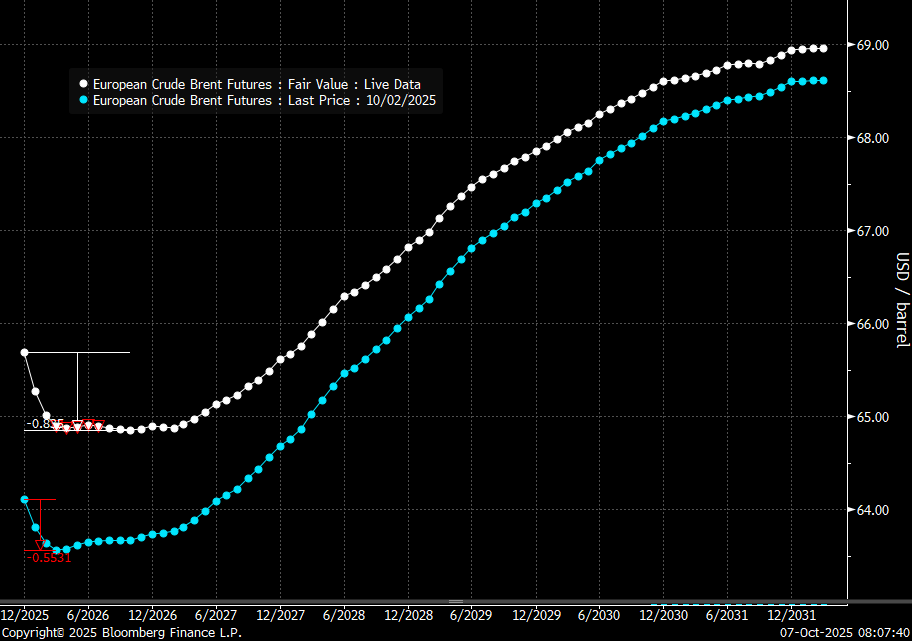
The front-end backwardation fell to its weakest level so far this year on Thursday last week. A slight pickup yesterday and today, but still very close to the weakest year to date. More oil from OPEC+ in the coming months and softer demand and rising inventories. We are heading for yet softer levels.
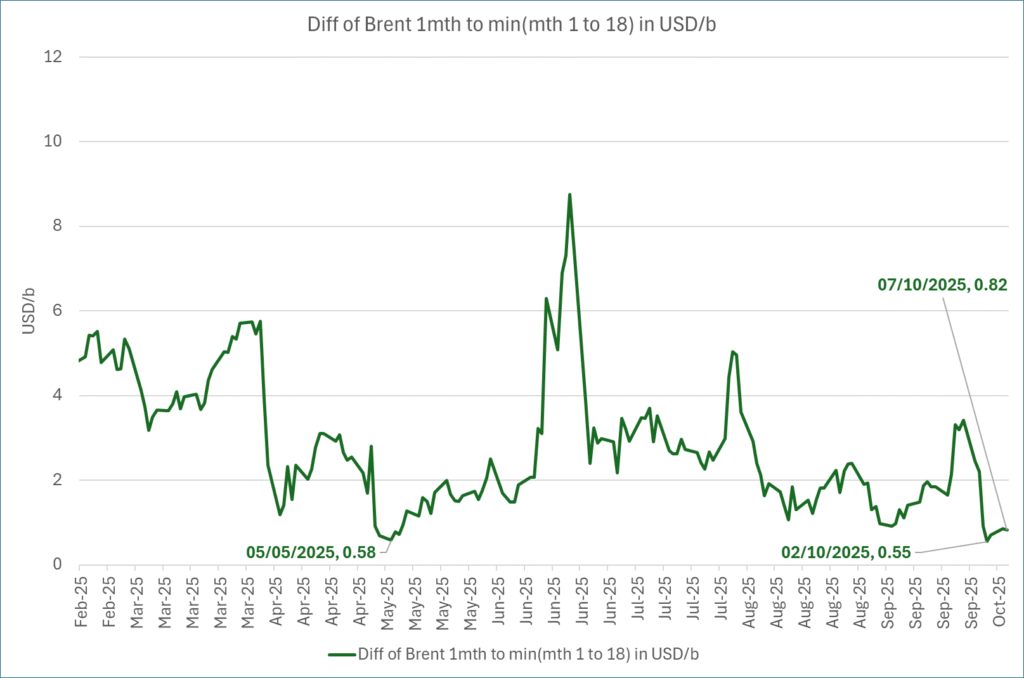
Analys
A sharp weakening at the core of the oil market: The Dubai curve

Down to the lowest since early May. Brent crude has fallen sharply the latest four days. It closed at USD 64.11/b yesterday which is the lowest since early May. It is staging a 1.3% rebound this morning along with gains in both equities and industrial metals with an added touch of support from a softer USD on top.

What stands out the most to us this week is the collapse in the Dubai one to three months time-spread.
Dubai is medium sour crude. OPEC+ is in general medium sour crude production. Asian refineries are predominantly designed to process medium sour crude. So Dubai is the real measure of the balance between OPEC+ holding back or not versus Asian oil demand for consumption and stock building.
A sharp weakening of the front-end of the Dubai curve. The front-end of the Dubai crude curve has been holding out very solidly throughout this summer while the front-end of the Brent and WTI curves have been steadily softening. But the strength in the Dubai curve in our view was carrying the crude oil market in general. A source of strength in the crude oil market. The core of the strength.
The now finally sharp decline of the front-end of the Dubai crude curve is thus a strong shift. Weakness in the Dubai crude marker is weakness in the core of the oil market. The core which has helped to hold the oil market elevated.
Facts supports the weakening. Add in facts of Iraq lifting production from Kurdistan through Turkey. Saudi Arabia lifting production to 10 mb/d in September (normal production level) and lifting exports as well as domestic demand for oil for power for air con is fading along with summer heat. Add also in counter seasonal rise in US crude and product stocks last week. US oil stocks usually decline by 1.3 mb/week this time of year. Last week they instead rose 6.4 mb/week (+7.2 mb if including SPR). Total US commercial oil stocks are now only 2.1 mb below the 2015-19 seasonal average. US oil stocks normally decline from now to Christmas. If they instead continue to rise, then it will be strongly counter seasonal rise and will create a very strong bearish pressure on oil prices.
Will OPEC+ lift its voluntary quotas by zero, 137 kb/d, 500 kb/d or 1.5 mb/d? On Sunday of course OPEC+ will decide on how much to unwind of the remaining 1.5 mb/d of voluntary quotas for November. Will it be 137 kb/d yet again as for October? Will it be 500 kb/d as was talked about earlier this week? Or will it be a full unwind in one go of 1.5 mb/d? We think most likely now it will be at least 500 kb/d and possibly a full unwind. We discussed this in a not earlier this week: ”500 kb/d of voluntary quotas in October. But a full unwind of 1.5 mb/d”
The strength in the front-end of the Dubai curve held out through summer while Brent and WTI curve structures weakened steadily. That core strength helped to keep flat crude oil prices elevated close to the 70-line. Now also the Dubai curve has given in.
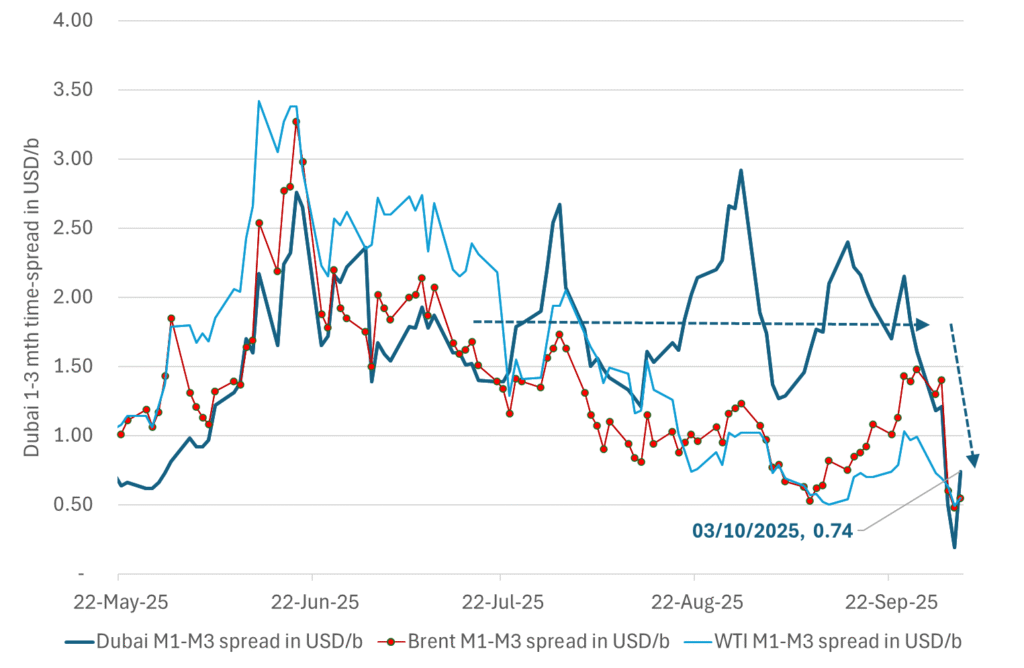
Brent crude oil forward curves
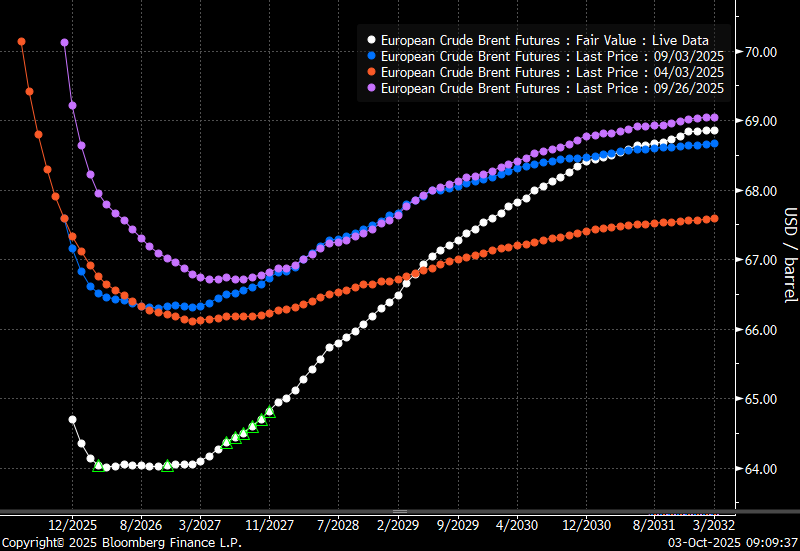
Total US commercial stocks now close to normal. Counter seasonal rise last week. Rest of year?
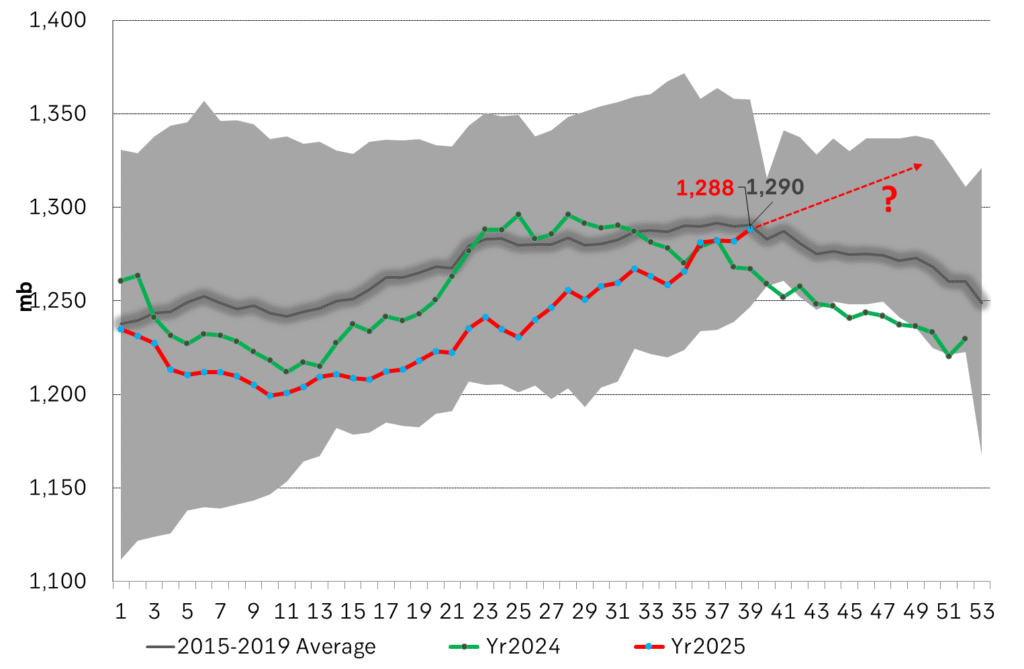
Total US crude and product stocks on a steady trend higher.
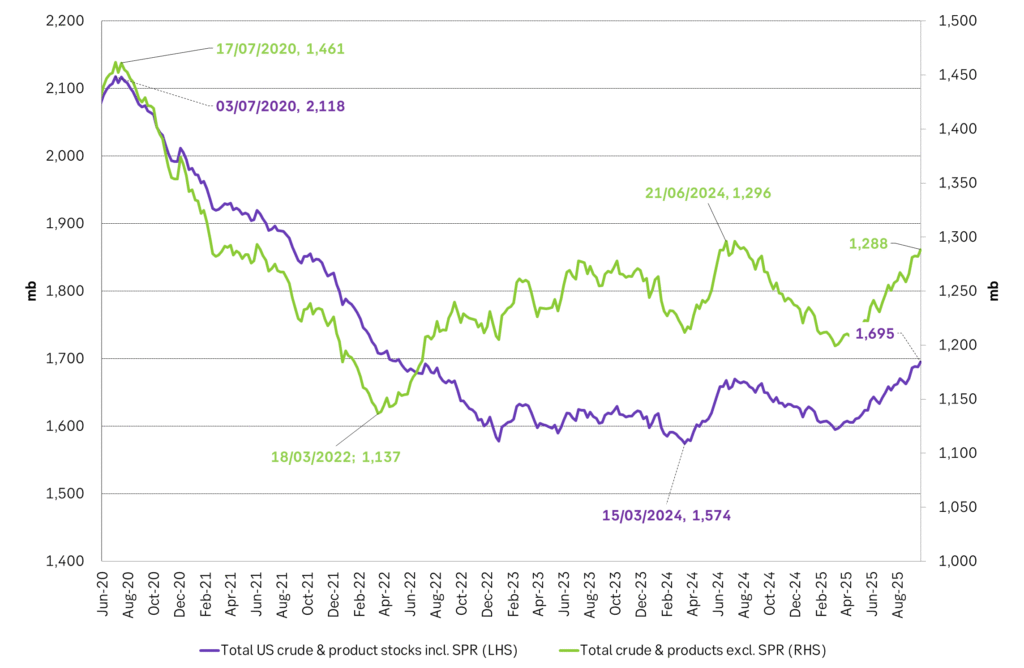
Analys
OPEC+ will likely unwind 500 kb/d of voluntary quotas in October. But a full unwind of 1.5 mb/d in one go could be in the cards

Down to mid-60ies as Iraq lifts production while Saudi may be tired of voluntary cut frugality. The Brent December contract dropped 1.6% yesterday to USD 66.03/b. This morning it is down another 0.3% to USD 65.8/b. The drop in the price came on the back of the combined news that Iraq has resumed 190 kb/d of production in Kurdistan with exports through Turkey while OPEC+ delegates send signals that the group will unwind the remaining 1.65 mb/d (less the 137 kb/d in October) of voluntary cuts at a pace of 500 kb/d per month pace.

Signals of accelerated unwind and Iraqi increase may be connected. Russia, Kazakhstan and Iraq were main offenders versus the voluntary quotas they had agreed to follow. Russia had a production ’debt’ (cumulative overproduction versus quota) of close to 90 mb in March this year while Kazakhstan had a ’debt’ of about 60 mb and the same for Iraq. This apparently made Saudi Arabia angry this spring. Why should Saudi Arabia hold back if the other voluntary cutters were just freeriding? Thus the sudden rapid unwinding of voluntary cuts. That is at least one angle of explanations for the accelerated unwinding.
If the offenders with production debts then refrained from lifting production as the voluntary cuts were rapidly unwinded, then they could ’pay back’ their ’debts’ as they would under-produce versus the new and steadily higher quotas.
Forget about Kazakhstan. Its production was just too far above the quotas with no hope that the country would hold back production due to cross-ownership of oil assets by international oil companies. But Russia and Iraq should be able to do it.
Iraqi cumulative overproduction versus quotas could reach 85-90 mb in October. Iraq has however steadily continued to overproduce by 3-5 mb per month. In July its new and gradually higher quota came close to equal with a cumulative overproduction of only 0.6 mb that month. In August again however its production had an overshoot of 100 kb/d or 3.1 mb for the month. Its cumulative production debt had then risen to close to 80 mb. We don’t know for September yet. But looking at October we now know that its production will likely average close to 4.5 mb/d due to the revival of 190 kb/d of production in Kurdistan. Its quota however will only be 4.24 mb/d. Its overproduction in October will thus likely be around 250 kb/d above its quota with its production debt rising another 7-8 mb to a total of close to 90 mb.
Again, why should Saudi Arabia be frugal while Iraq is freeriding. Better to get rid of the voluntary quotas as quickly as possible and then start all over with clean sheets.
Unwinding the remaining 1.513 mb/d in one go in October? If OPEC+ unwinds the remaining 1.513 mb/d of voluntary cuts in one big go in October, then Iraq’s quota will be around 4.4 mb/d for October versus its likely production of close to 4.5 mb/d for the coming month..
OPEC+ should thus unwind the remaining 1.513 mb/d (1.65 – 0.137 mb/d) in one go for October in order for the quota of Iraq to be able to keep track with Iraq’s actual production increase.
October 5 will show how it plays out. But a quota unwind of at least 500 kb/d for Oct seems likely. An overall increase of at least 500 kb/d in the voluntary quota for October looks likely. But it could be the whole 1.513 mb/d in one go. If the increase in the quota is ’only’ 500 kb/d then Iraqi cumulative production will still rise by 5.7 mb to a total of 85 mb in October.
Iraqi production debt versus quotas will likely rise by 5.7 mb in October if OPEC+ only lifts the overall quota by 500 kb/d in October. Here assuming historical production debt did not rise in September. That Iraq lifts its production by 190 kb/d in October to 4.47 mb/d (August level + 190 kb/d) and that OPEC+ unwinds 500 kb/d of the remining quotas in October when they decide on this on 5 October.
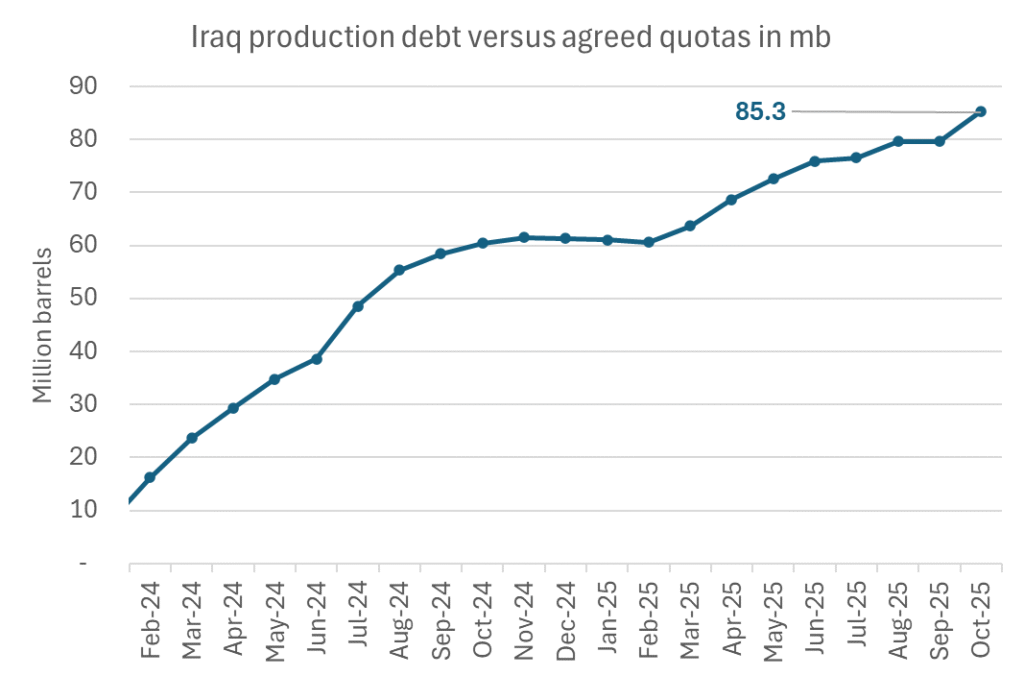
-

 Nyheter4 veckor sedan
Nyheter4 veckor sedanKinas elproduktion slog nytt rekord i augusti, vilket även kolkraft gjorde
-
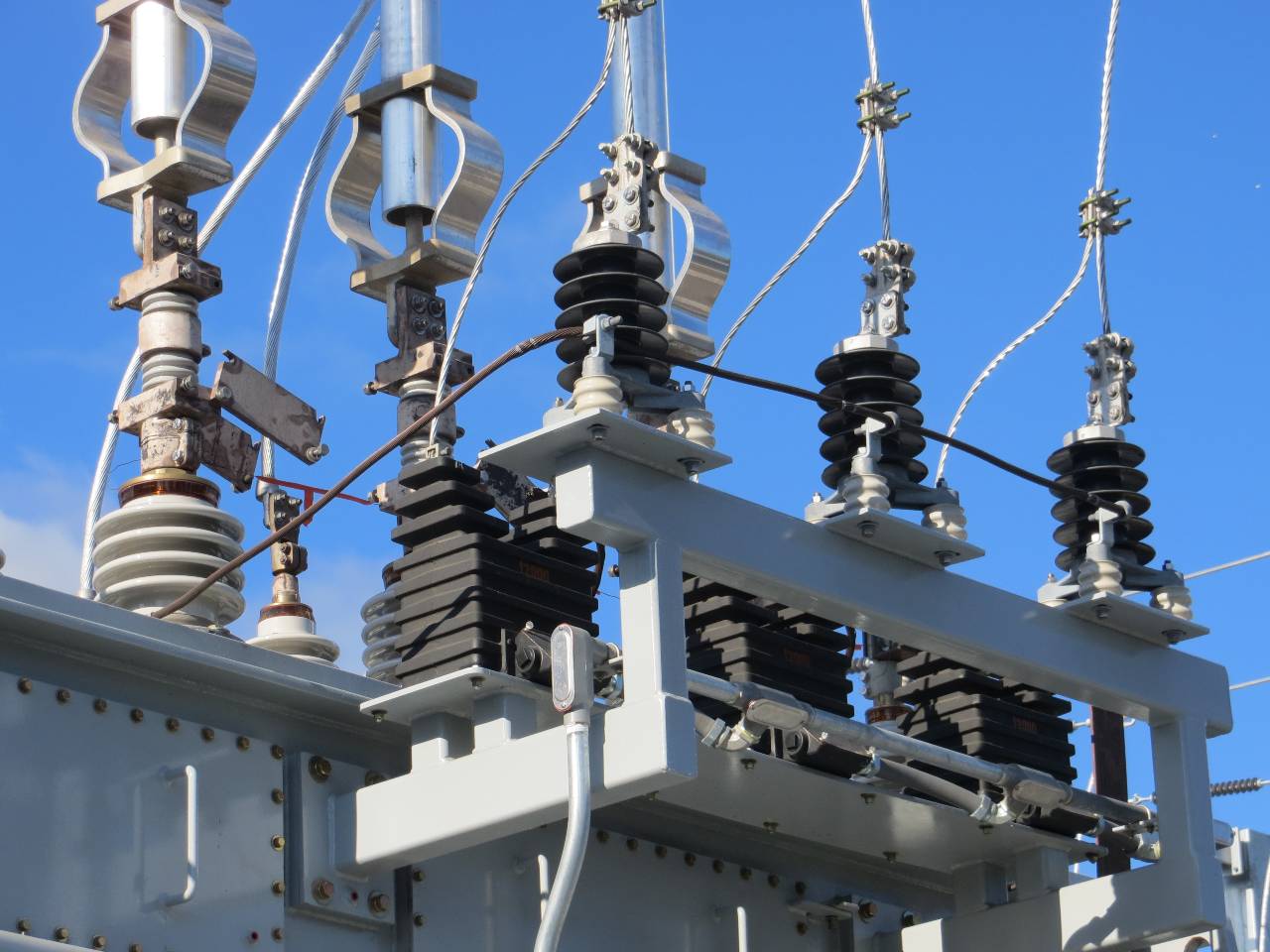
 Nyheter4 veckor sedan
Nyheter4 veckor sedanTyskland har så höga elpriser att företag inte har råd att använda elektricitet
-

 Nyheter3 veckor sedan
Nyheter3 veckor sedanOPEC+ missar produktionsmål, stöder oljepriserna
-

 Nyheter3 veckor sedan
Nyheter3 veckor sedanEtt samtal om guld, olja, fjärrvärme och förnybar energi
-

 Analys4 veckor sedan
Analys4 veckor sedanBrent crude ticks higher on tension, but market structure stays soft
-

 Analys3 veckor sedan
Analys3 veckor sedanAre Ukraine’s attacks on Russian energy infrastructure working?
-

 Nyheter2 veckor sedan
Nyheter2 veckor sedanGuld nära 4000 USD och silver 50 USD, därför kan de fortsätta stiga
-

 Nyheter3 veckor sedan
Nyheter3 veckor sedanGuldpriset uppe på nya höjder, nu 3750 USD










